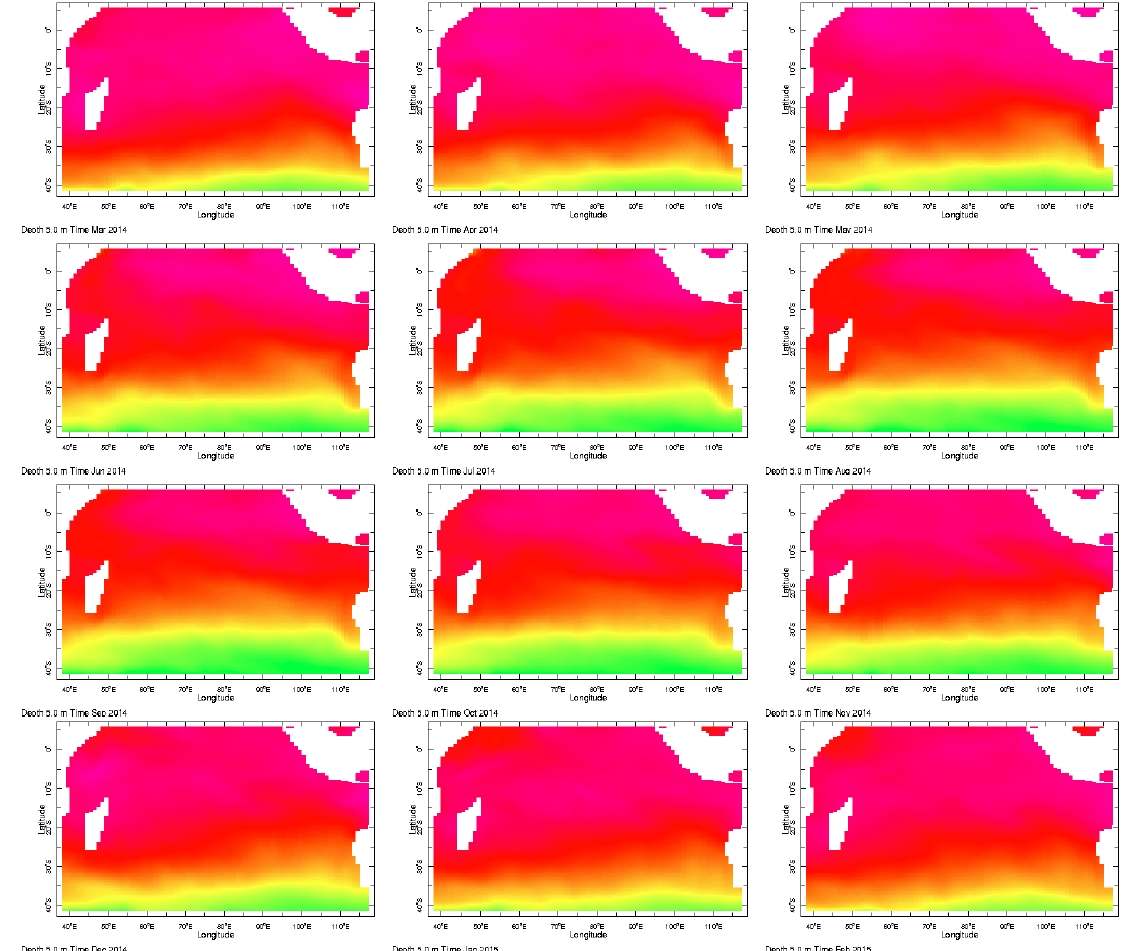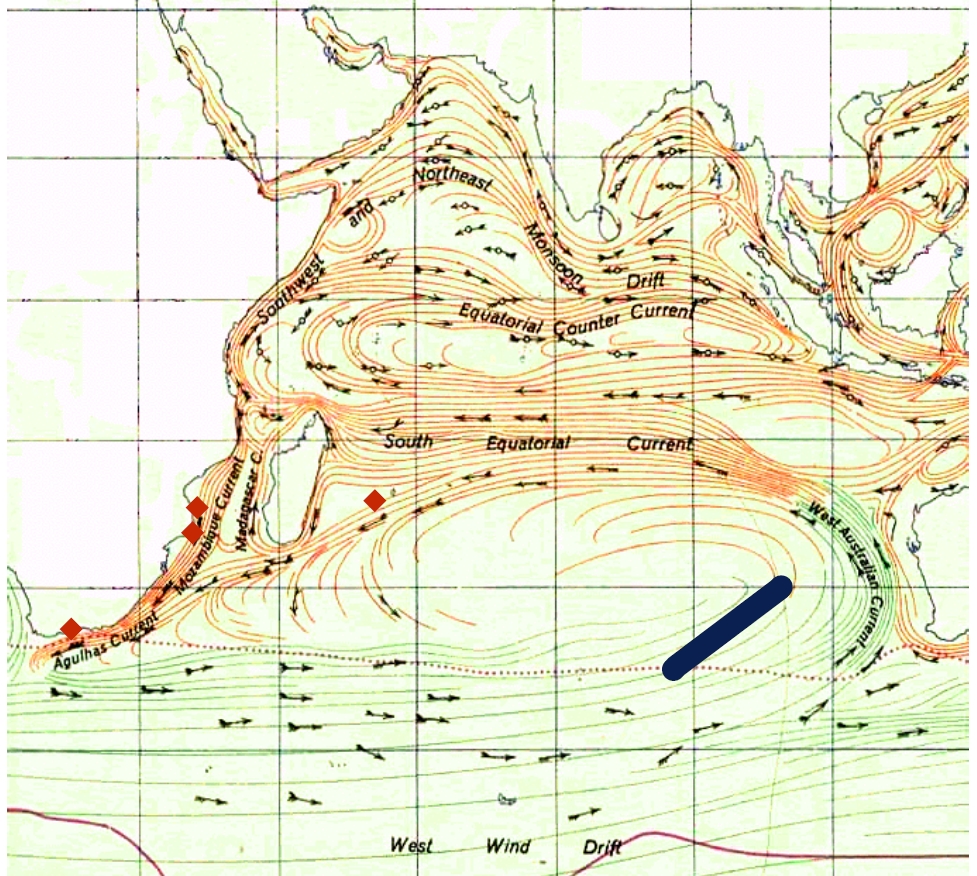The Routes Taken by
Floating Debris from MH370
Richard Godfrey
2016 April 2nd
(Please see also the addenda at the end of this post, including that inserted on April 4th in which the Rodrigues fragment is identified in terms of which part of the cabin it comprised.)
Preamble by Duncan Steel:
Since I received the following material for posting from Richard Godfrey about 23 hours ago, a further piece of MH370 has apparently been found on the island of Rodrigues. Independent Group (IG) member Don Thompson has been central in identifying this as likely being a piece from the passenger cabin interior: see
this early story in the media.
Before saying more on the significance of that, I might quote from
the previous post by Richard, in which was written: “
The next most likely destinations are Mozambique, Rodrigues, Mauritius…” One of the hallmarks of a viable scientific hypothesis is its ability to make predictions that are borne out by future observations or measurements.
My immediate response to the Rodrigues item is that, assuming that it is indeed from MH370, it provides another vital indication of the end-of-flight circumstances which could and should inform the ocean bottom search for the wreckage of MH370 and thus the flight recorders. The important thing here is that this is from the interior of the aircraft. The previous four fragments found were parts of the exterior. So long as only exterior fragments had been found, it was still possible to imagine that the aircraft had undergone a controlled ditching in the ocean, based on the idea that those pieces had been ripped off as the aircraft glided down onto the sea surface. The discovery of an interior cabin part indicates rather strongly that the aircraft disintegrated on arriving in the sea: it was a high-speed, uncontrolled crash, as has been argued many times on this website, for many reasons (e.g. the final BFO values are indicative of a very rapid, accelerating descent).
Richard’s analysis of the oceanic drift of floating debris from MH370, based on the model available on
the Adrift website (to which another tip of the hat is due), has a wide variety of outcomes in terms of general understandings. An important one is this: the probabilities derived for arriving at the various locations in the western Indian Ocean where MH370 debris has been found may be inverted so as to derive an estimate of how many individual fragments were left floating on the ocean after the crash. The answer is: upwards of 10,000. In itself that number indicates that the final demise of MH370 was a highly-energetic crash.
From the perspective of the underwater search for the wreckage of MH370 there are two important points to be made, to the general reader of this post but most importantly to the people leading the official search program:
(1) There must have been a vast field of floating debris from the crash, which dispersed over following weeks: if it was not seen from the surface-search aircraft then it seems very likely that the crash must have been in a location not covered by those aircraft; the obvious implication of this is: the ocean bottom search should be directed towards areas close to the 7th arc that were
not covered by the airborne search (so, see
this post and
this post).
(2) Whilst there was a large number of floating objects produced in the crash, there was surely also a large number of non-floating objects! That is, at the crash location there must have been many thousands of fragments with densities greater than unity, which sank immediately (unlike, say, suitcases which might take a while to become waterlogged and then sink elsewhere). The implication is that the debris field on the ocean bottom will be spread over some substantial area, dependent on various things such as the depth of the ocean at that location, rather than being a single point or restricted area where the aircraft sank largely intact. Clearly, it didn’t.
The important argument I wish to make here is that the swathes being scanned across the ocean bottom could be quite widely spaced, with spaces left between them to be covered later if required. It’s not necessary – indeed it is counter-productive – to have scan swathes that abut each other.
Before I pass the text over to Richard, here is a matter disconnected from the above, but referring to his post below. Richard has considered various mechanisms that might explain why the flaperon found on La Réunion was encrusted with many goose barnacles, whereas the three debris items discovered on the coast of Africa appeared to be bare of marine growths. One point he did not mention is this: that the ability of those three items to float and so reach the destinations where they were found may have been conditional upon them not being weighed down with barnacles. It might be the the flaperon had an average density (we still await public disclosure of the results of the tests conducted by the French authorities) low enough such that it could continue to float on the ocean despite its crustacean passengers, whereas the smaller items found in Mozambique and South Africa has densities only just less than one gram per cubic centimetre, such that any barnacles would have sunk them.
Finally I note that the initial photographs of the item found on Rodrigues indicate that it was carrying many barnacles.
Introduction
At the time of writing [DS: that was on March 31st/April 1st], there have been four finds of floating debris items that have either been confirmed or are considered highly-likely to be from MH370 (i.e. the Boeing 7772H6ER aircraft registered as 9M-MRO), as listed in the table below. It may be anticipated that more discoveries of fragments of the aircraft will be made in coming months, spread over the shores of the western Indian Ocean and eventually elsewhere.

In two recent posts (linked
here and
here) I have described my investigations of the dispersal by ocean currents of floating fragments from assumed crash locations in the eastern Indian Ocean, close to the 7th arc and between latitudes of 30S and 38S, and indicated both (i) where such items are more likely to wash ashore in the western Indian Ocean, and also (ii) the most likely origination (i.e. crash) locations between the above assumed limits. Such drift analyses should be regarded as being statistically-indicative, but by no means definitive: it is simply infeasible to trace the chaotic drift of specific items either in the forward- or backward-directions.
The first find (the flaperon discovered on La Réunion) carried a large and obvious population of barnacles, whereas the other three finds in the table above display a puzzling lack of evidence of marine life in publicly-available photographs; note, though, that examination and species identification has not yet been completed or published.
One possible explanation for this obvious difference between the flaperon and the other items might be linked to the differing routes taken by the floating debris, and this is a matter which I address in the present report.
There are warmer and there are colder ocean currents. There are variations in the nutrients in different ocean areas that are required to support different types of marine life. How might such considerations affect the growth of barnacles and other organisms on the floating debris?
Methodology
The
Indian Ocean South Equatorial Current drives floating debris generally westwards towards Africa. Madagascar, with a total coast line length of 4,828 km, then forces a divide of that broad current around its northern and southern tips. Whilst the currents are seasonally-variable, there are many maps available on the internet which indicate the divide being discussed herein, such as that shown below, or
this one.
General map of Indian Ocean currents, with the 7th arc between 30S and 38S broadly indicated in dark blue and the first four debris finds (locations as listed in the table above) marked in red.
According to
the Adrift model, 28 per cent more floating debris (i.e. a 56/44 split) would travel via the northern tip of Madagascar, for items originating between 30S and 38S on the 7th arc (see
my previous post for more information). The highest drift probabilities around both the northern and southern tips of Madagascar, are just off the coast rather than further offshore, as one might imagine. The time taken to reach the northern and southern tips of Madagascar ranges between 12 and 16 months (from the starting locations as given above).
I downloaded forward-drift data from
the Adrift website for both the northern tip of Madagascar at 12S 49E and the southern tip at 26S 46E for the months of January, March, May, July, September and November. As aforementioned, there are significant seasonal changes during the year.
Although the shortest routes to the Paindane (Mozambique), Paluma (Mozambique) and Mossel Beach (South Africa) debris finds are all from the southern tip of Madagascar, it happens that all three locations could be reached by the drift patterns via either northern or southern tips of the island. That is, the fragments could have taken routes either north of the island and down through the Mozambique Channel (perhaps joining the Agulhas Current), or else passing south of the island. But which is the more likely, in each case?
Results
The Paluma find is 1.5 times more likely to have arrived via the northern route; that route is also a much better fit to the time of discovery (end of February).
The Paindane item is 33 times more likely to have arrives via the southern route; that route is also a better fit to the time of discovery (end of December).
The Mossel Bay fragment is 3.7 times more likely to have arrived via the southern route; that route is also a better fit to the time of discovery (mid-March).
As a general statement (for these and likely — based on the drift modelling — many impending discoveries) it is conceivable that times of landfall and times of discovery may be separated by some months, especially in remote areas. In the four cases in the table above, however, it appears that the areas were regularly visited, so that the discoveries were made quite promptly after the items washed ashore.
It is also conceivable, even likely, that floating items might make landfall but return to the sea, perhaps washing up again in much the same location, or some distance away. The
Adrift model incorporates such a feature (that is, floating objects are assumed to be reflected rather than absorbed by a shoreline).
Discussion
(1) Implications of Indian Ocean sea surface temperatures
The ATSB has pointed out that a southern drift route generally occupies cooler waters than a northern route, and of course that is generally the case for routes south of the equator.
The graphic below comprises an overview of Indian Ocean sea surface temperature for each month of the year (thanks, Barry Martin).
Indian Ocean sea surface temperatures for each month of the year.
It would appear obvious that both a northern drift route to 12S 49E (i.e. the northern tip of Madagascar) and a southern route to 26S 46E (i.e. the southern tip) must spend significant time above latitude 30S, where barnacles apparently start to grow, although a path passing close by the southern tip might avoid spending much time to the north of 30S.
The three fragments found on the African coast
If floating debris took a path passing slightly further south of Madagascar then it could remain in colder waters (especially between July and October) below 30S, under which circumstance barnacle attachment and growth is contra-indicated. Thus it might be that the three items found on the coast of Africa reached their destinations via such more-southerly routes. Let us examine each in turn.
The Paluma item (‘NO STEP’) that arrived at around 22S might have been expected to show evidence marine life, because it most likely (from the drift modelling) followed a northern route in warmer waters; on the other hand, if no marine life attachments are/were identified, this might be interpreted as evidence that it took the southern route. (From the preceding discussion: 1.5 times more likely to have followed the northern route based on the drift modelling, and therefore a 40 per cent chance that it took the southern path.)
The Paindane item (‘676EB’) discovered at around 24S may well show some evidence of marine life, even though it most probably arrived via the southern route past Madagascar, mainly occupying cooler waters.
The Mossel Bay find (‘Rolls Royce’) might not be expected to show evidence of marine life because it was discovered at around 34S and may well have spent most of its ocean transport time in the cooler waters below 30S.
Modelled route of the flaperon to La Réunion
Contrasting with the above three items, the flaperon found in La Réunion at 21S carried many barnacles. Its estimated track is as below, based on an assumption that it started from close to the 7th arc between 34S and 37S.
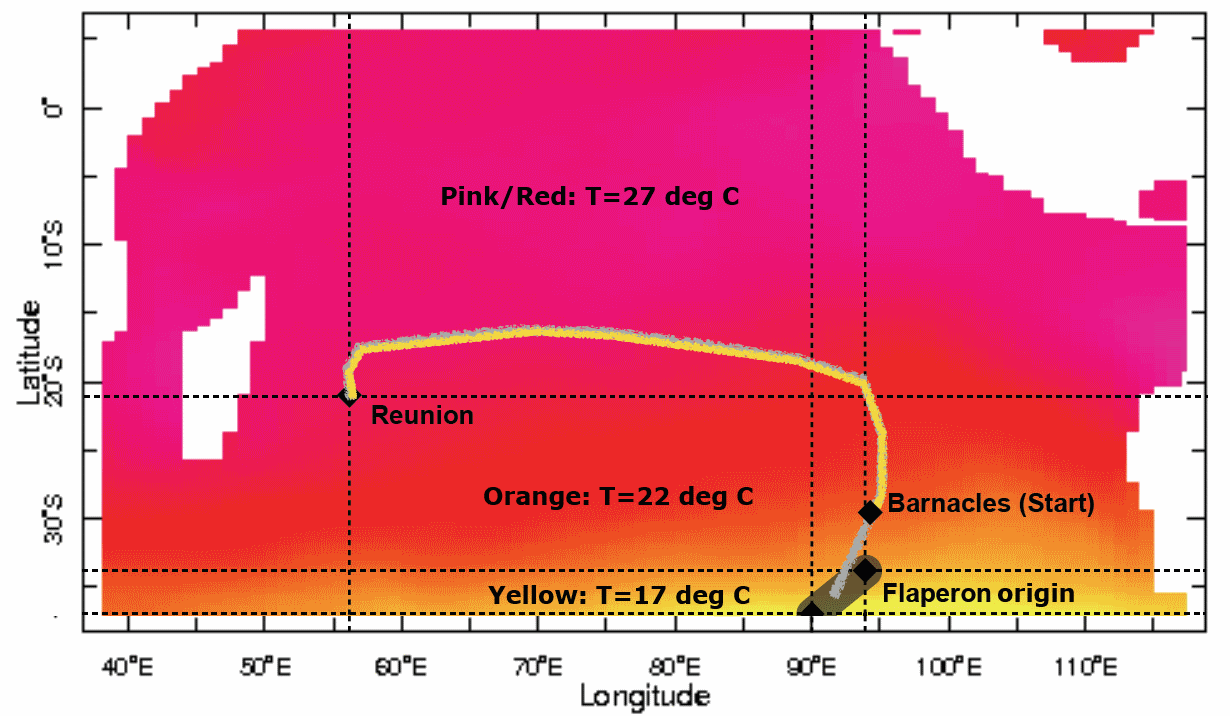
As can be seen, such a route would lead to the flaperon spending most of its drift time above 30S, thus perhaps enabling the substantial barnacle growth witnessed.
(2) Implications of Indian Ocean chlorophyll concentrations
At the base of the ocean food chain are single-celled algae and other plant-like organisms known as phytoplankton. Like plants on land, phytoplankton use chlorophyll and other light-harvesting pigments to facilitate photosynthesis. Where phytoplankton grow depends on the available sunlight, temperature, and nutrient levels. Because cold waters generally contain more nutrients than warm waters, phytoplankton tend to be more plentiful where the sea is cooler.
Marine growth (e.g. barnacles) on floating items is dependent upon the availability of their respective nutrients in the water, in this case the phytoplankton. Thus if phytoplankton concentrations are low, one may expect barnacle growth to be limited.
Measured chlorophyll concentrations may be interpreted as being indicators of phytoplankton levels. In the Indian Ocean the chlorophyll concentration varies considerably, for example due to the prevailing winds and other seasonal effects. In general, coastal regions (due to run-off nutrients) and colder waters (due to upwelling nutrients) are higher in chlorophyll concentrations.
In the following maps the chlorophyll concentrations are shown, scaled from purple/blue representing the lowest to yellow/red the highest, for the months May-June and September-October.
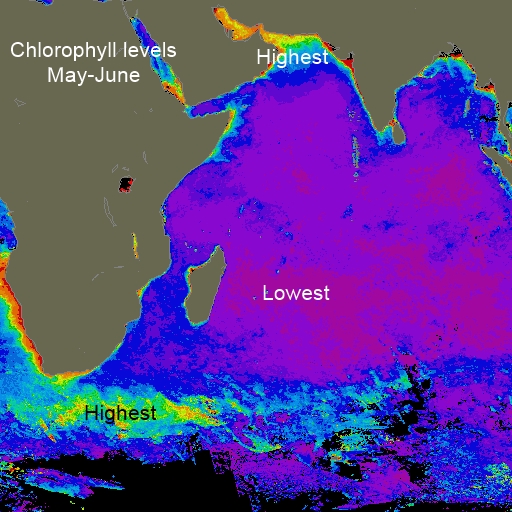
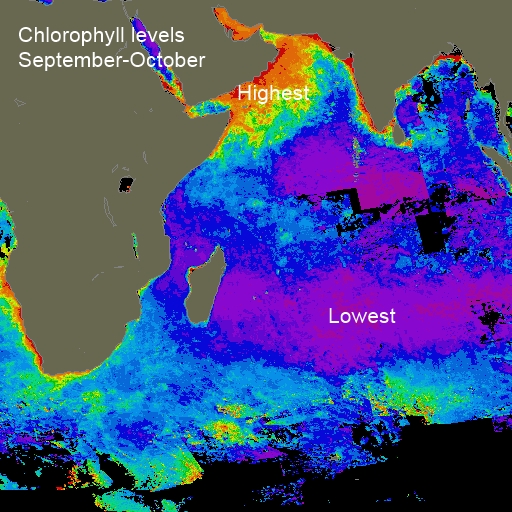
Although it appears likely that the floating debris from MH370 was carried westwards towards Africa by the Indian Ocean South Equatorial Current through warm waters (i.e. where barnacle attachment and growth is feasible), these waters have relatively low concentrations of chlorophyll in the maps above, and therefore limited amounts of phytoplankton, and this militates against substantial barnacle growth.
As floating debris spends time in coastal regions, higher concentrations of chlorophyll/phytoplankton and hence macroscopic marine life are experienced. One possibility, therefore, is that the flaperon found in La Réunion spent some time near the coast before landfall, whereas the coastal Africa finds beached as soon as they arrived.
Addendum from Richard Godfrey: The discovery of a fragment of the interior of MH370 on the island of Rodrigues, as discussed by Duncan in his preamble above, means that the list of debris finds should now be expanded, as below:
Addendum from Don Thompson: An alternative reason for the Réunion and Rodrigues items being barnacle-encrusted but not the other three might be as follows. The lepas (goose barnacle) colonisation may be a feature of proximity to coastlines inhabited by lepas colonies. Therefore, debris ‘dropped’ into a mid-ocean region (i.e. the crash site) might be expected to be ‘clean’ of lepas barnacles until free-swimming barnacle nauplii, released from reproducing coastal colonies, are encountered. That would fit with Réunion and Rodrigues, contrary to the sandy-shored arrival locations of the other items so far discovered. Colonisation of 9M-MRO debris by barnacles should generally be expected to be sparse.
Addendum April 4th, from Don Thompson: With respect to the fragment of the aircraft found on the beach in Rodrigues, it appears that Annette in Australia has identified rather precisely which part of the cabin it came from; see the edited and marked-up photograph here. One might watch, also, the final ten seconds of this YouTube video.

